Flat roofing for post-construction roof inspection and warranty walkthrough by Chicago Elite Commercial Flat Roofing in Chicago IL
At Chicago Elite Commercial Flat Roofing, we specialize in flat roofing for post-construction roof inspection and warranty walkthrough services in Chicago, IL. Once your flat roof installation is complete, a detailed post-construction inspection is essential to confirm that the roof meets all quality and safety standards. Our team conducts thorough evaluations to identify any potential issues early—before they turn into costly repairs. We don’t just inspect the roof’s surface; we assess the integrity of materials, workmanship, drainage systems, and overall structural soundness to ensure your flat roof will perform reliably over time.
Understanding your warranty is just as important as the inspection itself. Flat roofing for post-construction roof inspection and warranty walkthrough means we walk you through the specific terms of your warranty, clarifying coverage details, limitations, and maintenance requirements. This ensures you know exactly what is protected and how to maintain your roof properly to avoid voiding your warranty. We help you navigate the often-complex warranty language so you can make informed decisions about your roof’s upkeep.
Commercial flat roofing demands specialized expertise due to its unique design and exposure to harsh weather conditions common in Chicago. Our experienced technicians are trained to spot even subtle signs of potential problems that others might miss. When you choose Chicago Elite Commercial Flat Roofing, you’re choosing a partner committed to protecting your investment with transparent, reliable, and expert service. Our comprehensive inspections and clear warranty walkthroughs give you confidence that your flat roof is built to last and that you have the support needed should any issues arise.

Flat Roofing Post-Construction Inspection Services
We focus on verifying the integrity and workmanship of your flat roof after construction. Our thorough inspections ensure compliance with warranty terms and protect your investment over time.
Importance of Professional Roof Inspections
Professional inspections identify issues that are not visible to the untrained eye. We detect potential leaks, membrane damage, or structural weaknesses early, preventing costly repairs later.
Our certified inspectors understand flat roofing materials and installation techniques specific to commercial buildings. This expertise allows us to validate the workmanship and materials used, ensuring they meet industry standards.
Timely inspections secure warranty coverage by documenting roof conditions before issues develop. This protects property owners from unexpected expenses and extends the roof’s lifespan.

Inspection Process Overview
We begin with a visual review of the roof surface, checking for uniformity and proper installation of membranes. Next, we assess roof penetrations like vents, drains, and seams for secure sealing.
Detailed photos and notes accompany every inspection to provide clear evidence of the roof’s condition. We compile this data into a comprehensive report for our clients and warranty providers.
We also perform moisture scans and use infrared technology to detect hidden water intrusion beneath the roofing layers. This method helps uncover problems before they escalate.
Critical Areas Examined During Inspections
We closely examine the roof membrane for punctures, blisters, or wrinkles that compromise waterproofing. Flashing around vents, skylights, and edges is inspected to prevent water ingress.
Drains and scuppers are checked to ensure they are clear and functioning correctly. Proper drainage is essential to avoid water pooling, which can weaken the roofing system.
We evaluate rooftop equipment supports and attachments to verify they do not damage the membrane or roof deck. Structural components are inspected for signs of stress or movement.
Warranty Walkthrough for Flat Roofing Systems
We aim to ensure our flat roofing installations meet strict standards and that your warranty remains valid through regular inspections. This process clarifies responsibilities and sets clear timelines to prevent any coverage issues.
Purpose of Warranty Walkthroughs
Warranty walkthroughs are designed to verify the condition of your flat roof after installation and during the warranty period. We inspect for signs of defects, improper installation, or damage that could affect warranty coverage.
This inspection helps identify any issues early, allowing us to address them before they escalate. It also confirms that the roof meets the manufacturer's specifications, which is crucial for maintaining warranty validity.
Client Responsibilities During Warranty Review
Clients must provide access to the roofing system during scheduled walkthroughs. This includes clearing any equipment or obstructions that might hinder inspection.
We advise clients to report visible signs of damage or leaks promptly to support our evaluation. Keeping records of maintenance and repairs can also aid in warranty claims.
Timeline and Scheduling for Walkthroughs
We conduct the initial warranty walkthrough soon after project completion, typically within 30 to 60 days. Subsequent inspections align with the warranty terms, often annually or biannually.
Scheduling is coordinated with clients to minimize disruption. Timely participation ensures ongoing compliance with warranty conditions and helps extend the roof’s lifespan.
Benefits of Routine Post-Construction Inspections
Regular post-construction inspections help identify potential problems early and extend the roof’s functional life. They allow us to confirm that the installation meets specifications and that the roofing system performs as expected under warranty terms.

Early Issue Detection
We focus on catching minor defects before they escalate into major problems. Small leaks, membrane blisters, or improper flashing can be spotted quickly during these inspections. Early detection enables timely repairs that prevent water damage, mold growth, and structural deterioration.
Addressing problems soon after construction saves money by avoiding costly emergency repairs or premature roof replacement. Our thorough walkthroughs cover all critical areas, ensuring no defects are overlooked.
Advanced Waterproofing Systems
Maximizing Roofing System Lifespan
Routine inspections contribute directly to maximizing your flat roof’s lifespan. We verify that all components are intact, materials remain secure, and drainage systems function correctly. This proactive approach helps maintain roof integrity, reducing material degradation caused by water pooling or UV exposure.
By adhering to manufacturer warranty guidelines through documented inspections, we preserve coverage and support long-term roof performance. We also provide maintenance recommendations based on inspection findings to optimize durability.
Frequently Asked Questions
After a commercial flat roof installation, it’s critical to have a thorough post-construction inspection and warranty walkthrough. Our experts at Chicago Elite Commercial Flat Roofing provide detailed inspections to catch any issues early and guide you through warranty terms so you’re protected.
What is included in a post-construction flat roof inspection?
We check the entire roofing system for proper installation, material defects, drainage issues, and any signs of damage. The goal is to confirm the roof meets specifications and manufacturer standards.
Why is a warranty walkthrough necessary after roof installation?
A warranty walkthrough clarifies what’s covered, how to maintain your roof, and the process for filing claims. It helps avoid misunderstandings and ensures you’re fully protected.
How soon after construction should the inspection and walkthrough happen?
Typically within 30 to 60 days after completion. Early inspection catches potential problems before they worsen and confirms the roof is performing correctly.
Can Chicago Elite Commercial Flat Roofing help with manufacturer warranty claims?
Yes. We assist clients in understanding warranty terms and handle claim submissions if defects or issues arise during the warranty period.
What common issues do post-construction inspections find on flat roofs?
Poor drainage, membrane blisters, seam problems, and improper flashing are typical issues we look for.
